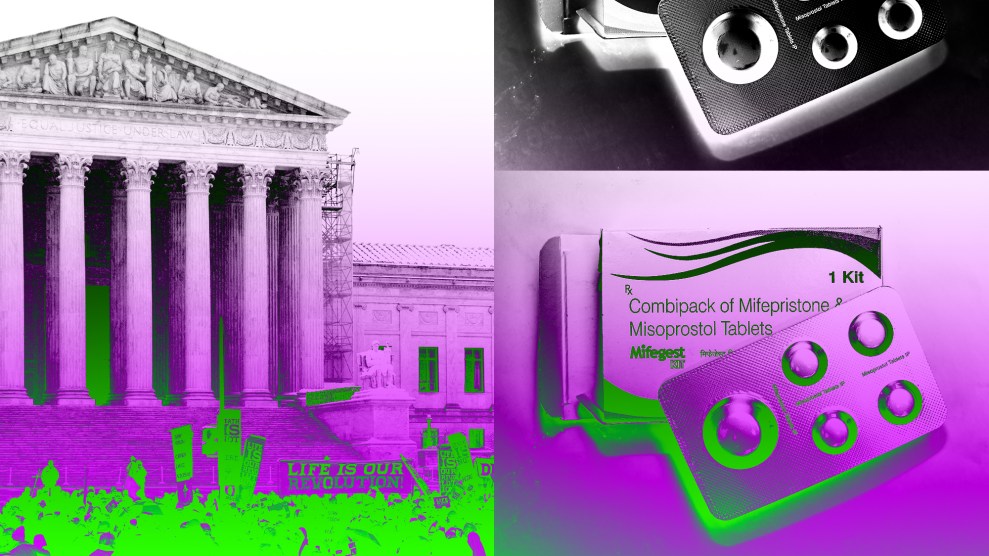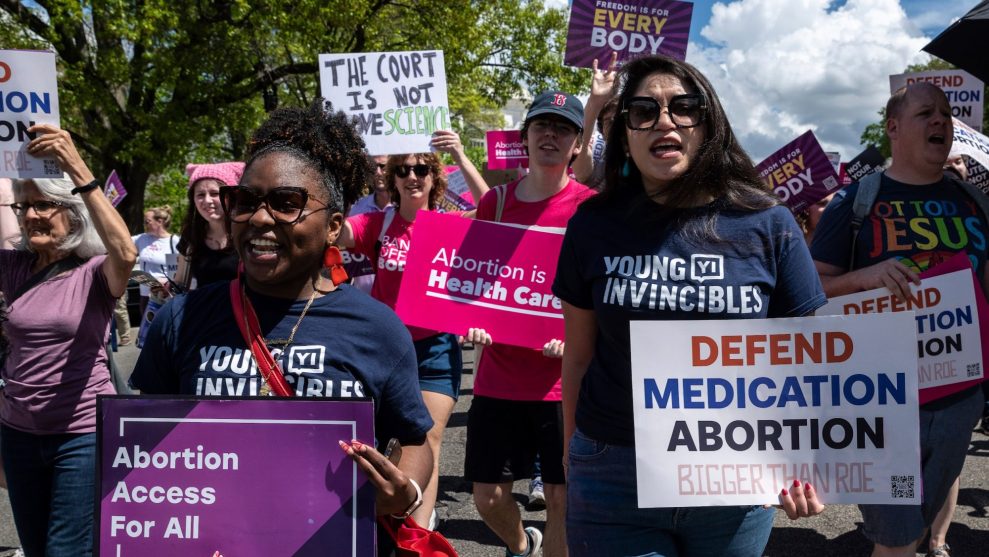
Mother Jones illustration; Bryan Olin Dozier/NurPhoto/ZUMA; Soumyabrata Roy/NurPhoto/ZUMA
The last time lawyers from the Alliance Defending Freedom argued before the Supreme Court, their case was entirely hypothetical. The conservative Christian legal advocacy group—the force behind some of the most important anti-abortion and anti-LGBTQ litigation in recent history—was representing a Colorado graphic designer who claimed to be starting a wedding website business, and wanted the right to deny service to same-sex couples. The designer had never before made a wedding website, and the only evidence that a queer couple wanted her to do so, it was later revealed, appeared to be faked. None of that mattered. The court gave her a guarantee that she wouldn’t be punished—creating a new loophole in anti-discrimination laws across the country.
On Tuesday, another ADF lawsuit will be heard at the Supreme Court. And once again, the case rests on a hypothetical: That a member of a small anti-abortion doctors’ coalition might one day have to care for a patient suffering a rare and severe complication from an FDA-approved abortion pill that the American Medical Association considers as safe as Tylenol. Perhaps, the case speculates, that doctor might be forced to administer that patient an emergency abortion, violating their anti-abortion convictions.
This lawsuit—known as FDA v. Alliance for Hippocratic Medicine—aims to limit the availability of mifepristone, the first pill in the two-drug regimen commonly used in medication abortions. ADF, on behalf of the anti-abortion doctors, accuses the FDA of “betraying women and girls” when it approved mifepristone 23 years ago by overlooking potentially harmful side effects and by later making it easier to get. The case has the potential to produce the most consequential abortion ruling since 2022, when, in its Dobbs decision, the court ended the constitutional right to an abortion by upholding a Mississippi law that had been written by ADF. Since that decision, 14 states have made it illegal to provide abortion in virtually all cases, and seven more have restricted abortion to earlier in pregnancy. Now, with Tuesday’s case, the Supreme Court could broadly limit access to mifepristone—even in blue states that protect people’s right to end their pregnancy.
The lawsuit first made headlines last spring when a federal judge in Texas, Matthew Kacsmaryk, issued an unprecedented order to take mifepristone off the market entirely, nationwide. Kacsmaryk, a Trump appointee and former lawyer for a religious-right firm, purported to place a “stay” on the FDA’s 23-year-old approval of mifepristone, which has been used by millions of pregnant people in the US over the last two decades. It wasn’t an accident that the controversial judge happened to hear the case. ADF strategically filed in Amarillo, Texas, where Kacsmaryk heard 95 percent of civil cases—and where any appeals are directed to the notoriously right-leaning Fifth Circuit.
Thankfully, Kacsmaryk’s order never took effect, as the Biden administration swiftly appealed the case up to the Supreme Court, which hit pause until the justices got a fuller chance to consider the arguments. Now, that day is finally here, as the ADF prepares to face off in front of the high court with the Justice Department and lawyers for Danco, the manufacturer of brand-name mifepristone.
The stakes of the case have changed somewhat since Kacsmaryk’s order, with the Supreme Court already having decided not to review the portion of a ruling by the conservative Fifth Circuit that, while agreeing with most of the doctors’ arguments, held it was too late for ADF to challenge the FDA’s original approval of mifepristone. What’s still at stake are a series of subsequent FDA rule changes that made the drug easier to access. In 2016, the agency allowed mifepristone to be prescribed up to 10 weeks into pregnancy, rather than seven—almost doubling the number of patients who benefit from it, according to the Kaiser Family Foundation—while cutting the recommended dosage by two-thirds, and allowing certified nurse practitioners and physician assistants to prescribe the pills. It also reduced the number of required clinic visits from three to one, allowing patients to get mifepristone at a single appointment, without follow-ups.
Five years later, in response to the Covid pandemic, the FDA cut the office visit requirement—opening the door for telehealth prescriptions and mailed pills. The decision made it cheaper and simpler than ever to get an abortion in the early stages of pregnancy—especially for people who cannot take time off work, lack transportation, or are experiencing domestic violence. By last September, 16 percent of all abortions were done using telehealth, according to research by Ohio State University, the University of California-San Francisco, and the Society of Family Planning.
In their lawsuit, the anti-abortion doctors contend the FDA put patients in danger by removing these requirements, especially the office visit. The data isn’t on their side: Last month, a study in the journal Nature Medicine looked at 6,000 medication abortions provided by virtual clinics, and found that about 98 percent of them were effective without any additional intervention, and 99.8 percent were “not followed by serious adverse events,” as my colleague Julianne McShane reported.
From the beginning, the anti-abortion doctors’ arguments have been cloaked in such faux concerns about mifepristone’s safety. In their original complaint, the doctors argued that the FDA hadn’t had enough evidence to approve the drug or loosen regulations on it, and they cited flimsy research to suggest mifepristone was harmful. Those claims have been roundly debunked by mainstream medical associations, which explain that mifepristone is backed by decades of data. Even before it came to the United States, the drug was used for years for abortions in Europe; since its approval here in 2000, around 6 million people in the US have taken it. As the New York Times reports, more than 100 scientific studies have concluded that mifepristone is a safe way to end a pregnancy.
Meanwhile. it turns out that some of the studies cited by the doctors weren’t scientific at all. One, relied on in Kacsmaryk’s decision, was based on anonymous blog posts from a site called “Abortion Changes You.” Last month, a journal retracted three other papers cited by ADF in the case, explaining that an independent review had found “fundamental problems,” “incorrect factual assumptions,” “material errors,” and “misleading presentations.” Sage, the studies’ publisher, reported that nearly all their authors had affiliations with anti-abortion advocacy groups yet had not disclosed any conflicts of interest.
Of course, the real reason mifepristone is a target isn’t a result of science, but rather simple math: Medication abortions are immensely popular, accounting for nearly two-thirds of all abortions across the country. Thanks to recently enacted “shield laws” in a handful of states, including California and Massachusetts, providers there can now prescribe the pills to patients in states with abortion bans.
The Supreme Court might avoid ruling on the challenges to the FDA’s mifepristone regulations if it first decides the Alliance for Hippocratic Medicine doctors don’t even have legal standing to bring the case—and court observers say it’s not at all clear that they do. It all comes down to that original hypothetical. As Alison Clapman at the Brennan Center for Justice explains, because the doctors don’t prescribe mifepristone themselves, they’ve had to settle for arguing that they face “imminent” injury from the FDA decisions that increase mifepristone access. The argument that they deserve this day in court is that sometime in the future, an emergency physician who is a member of their group will likely be forced to treat a patient with mifepristone complications, and will feel psychological harm from doing so.
Danco, in its its petition to the Supreme Court, pointed that the doctors’ claim rests on a “series of contingencies: that a woman will obtain mifepristone from another provider; that she will suffer an extremely rare serious adverse event; and that, rather than returning to her provider or another provider that was previously identified, she will seek care from one of respondents’ members.”
It was not clear that this hypothetical patient would need an emergency abortion, Danco argued—or the doctors would be forced to provide it rather than refer her to a colleague, as federal conscience laws allow them to do. “To describe those theories [of standing] is to refute them,” the company wrote. “This Court has repeatedly rejected theories of standing that rest on a ‘speculative chain of possibilities.’ especially where, as here, those possibilities depend on ‘unfettered choices made by independent actors.'”
Tossing the case out on a lack of standing would be an easy way for the judges to keep the status quo. But remember, this is the court that overturned Roe v. Wade, and it could be eager to use Tuesday’s case to seize a similar opportunity. It remains to be seen whether judicial norms around standing—much less the weight of the scientific record—will stop the court’s conservative majority from taking another swipe at abortion access.
















